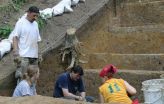(Press-News.org) Boulder, Colorado, USA – In the February 2013 issue of GSA Today, Sean Gallen and his colleagues from the Department of Marine, Earth, and Atmospheric Sciences at North Carolina State University take a new look at the origin of the Miocene rejuvenation of topographic relief in the southern Appalachians.
Conventional wisdom holds that the southern Appalachian Mountains have not experienced a significant phase of tectonic forcing for more than 200 million years; yet, they share many characteristics with tectonically active settings, including locally high topographic relief, steep slopes, incised river gorges, and frequent mass-wasting events.
Two competing hypotheses are commonly used to explain their modern topographic expression. One suggests that relief is largely controlled by variable lithologic resistance to weathering and that their modern form has long persisted in a dynamic equilibrium. The second postulates that their relief is a product of recent rejuvenation, driven either by climate change or the epeirogenic uplift of the land surface driven by mantle forcing.
Within portions of the Cullasaja River basin of the southern Appalachians, Gallen and colleagues show that relief has increased by more than 150% since the Miocene. Evident within the basin are a set of retreating knickpoints that delineate a rugged, actively incising landscape from lower-relief relict topography. Constraints on the timing of knickpoint entry into the basin suggest that the process of landscape rejuvenation began well prior to the late Cenozoic (earlier than four million years ago) transition to a more oscillatory (glacial-interglacial) climate regime. Furthermore, the geomorphology of the Cullasaja River basin is difficult to reconcile in the context of a transition to a more erosive climatic regime but is consistent with an epeirogenically uplifted landscape. Consequently, these observations lend new support to the idea that the rugged topography of the southern Appalachians has developed in response to post-orogenic regional uplift in the Miocene.
###
Miocene rejuvenation of topographic relief in the southern Appalachians
Sean F. Gallen, Karl W. Wegmann, and DelWayne R. Bohnenstiehl, Dept. of Marine, Earth, and Atmospheric Sciences, North Carolina State University, 2800 Faucette Drive, Raleigh, North Carolina 27695, USA. Pages 4-10; doi: 10.1130/GSATG163A.1, http://www.geosociety.org/gsatoday/archive/23/2/article/i1052-5173-23-2-4.htm.
GSA Today articles are open access online; for a print copy, please contact Kea Giles. Please discuss articles of interest with the authors before publishing stories on their work, and please make reference to GSA Today in articles published.
www.geosociety.org
Geological Society of America
Release No. 13-05 END
Rejuvenation of the Southern Appalachians
The February 2013 GSA Today is now online
2013-01-31
ELSE PRESS RELEASES FROM THIS DATE:
Empathy and age
2013-01-31
According to a new study of more than 75,000 adults, women in that age group are more empathic than men of the same age and than younger or older people.
"Overall, late middle-aged adults were higher in both of the aspects of empathy that we measured," says Sara Konrath, co-author of an article on age and empathy forthcoming in the Journals of Gerontology: Psychological and Social Sciences.
"They reported that they were more likely to react emotionally to the experiences of others, and they were also more likely to try to understand how things looked from the perspective ...
UNC scientists unveil a superbug's secret to antibiotic resistance
2013-01-31
Worldwide, many strains of the bacterium Staphyloccocus aureus, commonly known as staph infections, are already resistant to all antibiotics except vancomycin. But as bacteria are becoming resistant to this once powerful antidote, S. aureus has moved one step closer to becoming an unstoppable killer. Now, researchers at the University of North Carolina at Chapel Hill have not only identified the mechanism by which vancomycin resistance spreads from one bacterium to the next, but also have suggested ways to potentially stop the transfer.
The work, led by Matthew Redinbo, ...
Binge drinking increases risk of Type 2 diabetes by causing insulin resistance
2013-01-31
Binge drinking causes insulin resistance, which increases the risk of Type 2 diabetes, according to the results of an animal study led by researchers at the Diabetes Obesity and Metabolism Institute at the Icahn School of Medicine at Mount Sinai. The authors further discovered that alcohol disrupts insulin-receptor signaling by causing inflammation in the hypothalamus area of the brain.
The results are published in the January 30 issue of the journal Science Translational Medicine.
"Insulin resistance has emerged as a key metabolic defect leading to Type 2 diabetes ...
Mount Sinai launches clinical trial to treat chronic pulmonary sarcoidosis
2013-01-31
Patients are currently being enrolled in the first clinical trial to investigate the efficacy of immunological therapy for chronic pulmonary sarcoidosis. The trial is being conducted by researchers at the Icahn School of Medicine at Mount Sinai.
Mount Sinai has the largest Sarcoidosis Service in the world and is one of only two institutions in the country participating in the trial; the other is the University of Cincinnati. Mount Sinai is a National Institutes of Health Center of Excellence for research in sarcoidosis.
"The current standard treatment for chronic pulmonary ...
New semiconductor research may extend integrated circuit battery life tenfold
2013-01-31
Researchers at Rochester Institute of Technology, international semiconductor consortium SEMATECH and Texas State University have demonstrated that use of new methods and materials for building integrated circuits can reduce power—extending battery life to 10 times longer for mobile applications compared to conventional transistors.
The key to the breakthrough is a tunneling field effect transistor. Transistors are switches that control the movement of electrons through material to conduct the electrical currents needed to run circuits. Unlike standard transistors, which ...
Satellite image shows eastern US severe weather system
2013-01-31
A powerful cold front moving from the central United States to the East Coast is wiping out spring-like temperatures and replacing them with winter-time temperatures with powerful storms in between. An image released from NASA using data from NOAA's GOES-13 satellite provides a stunning look at the powerful system that brings a return to winter weather in its wake.
On Jan. 30 at 1825 UTC (1:25 p.m. EST), NOAA's GOES-13 satellite captured an image of clouds associated with the strong cold front. The visible GOES-13 image shows a line of clouds that stretch from Canada ...
NASA-NOAA's Suomi NPP satellite sees powerful Cyclone Felleng
2013-01-31
False-colored night-time satellite imagery from NASA-NOAA's Suomi NPP satellite clearly shows bands of thunderstorms wrapping into the eye of Cyclone Felleng as it parallels the coast of eastern Madagascar.
The Visible Infrared Imager Radiometer Suite (VIIRS) aboard NASA-NOAA's Suomi NPP satellite captured a night-time image of Cyclone Felleng when it was located east of Madagascar (4:09 p.m. EST/Jan. 30 at 12:09 a.m. local time, Madagascar). The image was created at the University of Wisconsin-Madison and was false colored to reveal temperatures. The image shows powerful ...
Rutgers physics professors find new order in quantum electronic material
2013-01-31
Two Rutgers physics professors have proposed an explanation for a new type of order, or symmetry, in an exotic material made with uranium – a theory that may one day lead to enhanced computer displays and data storage systems and more powerful superconducting magnets for medical imaging and levitating high-speed trains.
Their discovery, published in this week's issue of the journal Nature, has piqued the interest of scientists worldwide. It is one of the rare theory-only papers that this selective publication accepts. Typically the journal's papers describe results of ...
Archaic Native Americans built massive Louisiana mound in less than 90 days
2013-01-31
Nominated early this year for recognition on the UNESCO World Heritage List, which includes such famous cultural sites as the Taj Mahal, Machu Picchu and Stonehenge, the earthen works at Poverty Point, La., have been described as one of the world's greatest feats of construction by an archaic civilization of hunters and gatherers.
Now, new research in the current issue of the journal Geoarchaeology, offers compelling evidence that one of the massive earthen mounds at Poverty Point was constructed in less than 90 days, and perhaps as quickly as 30 days — an incredible ...
REACH news: European ombudsman takes up PETA complaint
2013-01-31
London – In response to a complaint by People for the Ethical Treatment of Animals (PETA), the European Ombudsman has launched an inquiry into the actions of the European Union (EU) agency responsible for the administration of the REACH chemical-testing program, which is expected to consume millions of animals in toxicity tests. PETA's complaint, submitted in July 2012, alleges that the European Chemicals Agency (ECHA) is not properly investigating cases in which animal testing could be avoided under the rules of REACH. PETA maintains that evidence derived from public documents ...
LAST 30 PRESS RELEASES:
Structural findings reveal how distinct GPCR ligands create different levels of activation
Anything-goes “anyons” may be at the root of surprising quantum experiments
UC review: Maximizing workplace opportunity for veterans
From generation to complex control: Metasurfaces make perfect vortex beams "within reach"
Thin-film lithium niobate-based detector: recent advances and perspectives
Exploring why some people may tend to persistently make bad choices
How cells balance their protein levels
Nirsevimab vs RSVpreF vaccine for RSV–related hospitalization in newborns
Effectiveness and impact of maternal RSV immunization and nirsevimab on medically attended RSV in US children
AI gives scientists a boost, but at the cost of too many mediocre papers
Next-generation vision model maps tree growth at sub-meter precision
Genes aren’t destiny for inherited blindness, study shows
MIT study: High-fat diets make liver cells more likely to become cancerous
Exposure to multiple fine particulate matter components and incident depression in the US Medicare population
Risk of burdensome health care spending over time in the US
Nirsevimab against hospitalizations and emergency department visits for lower respiratory tract infection in infants
New microfluidics technology enables highly uniform DNA condensate formation
A new strategy for immune tolerance
Super Mario Bros. help fight burnout: New study links classic games to boosted happiness
Deepest gas hydrate cold seep ever discovered in the arctic: International research team unveils Freya Hydrate Mounds at 3,640 m depth.
Integrating light and structure: Smarter mapping for fragile wetland ecosystems
ACA-SIM: A robust way to decode satellite signals over complex waters
Probiotics can restore gut microbiome in breastfed infants
AI could help predict nutrition risks in ICU patients, study finds
Federal EITC has unexpected result, researchers say – it decreases domestic violence
Researchers identify gene that calms the mind and improves attention in mice
Artificial metabolism turns waste CO2 into useful chemicals
Ancient sea anemone sheds light on animal cell type evolution
Begging gene leads to drone food
How climate policies that incentivize and penalize can drive the clean energy transition
[Press-News.org] Rejuvenation of the Southern AppalachiansThe February 2013 GSA Today is now online


